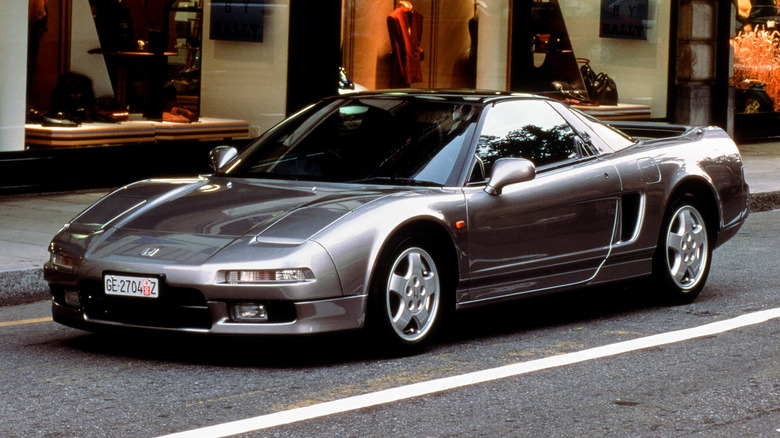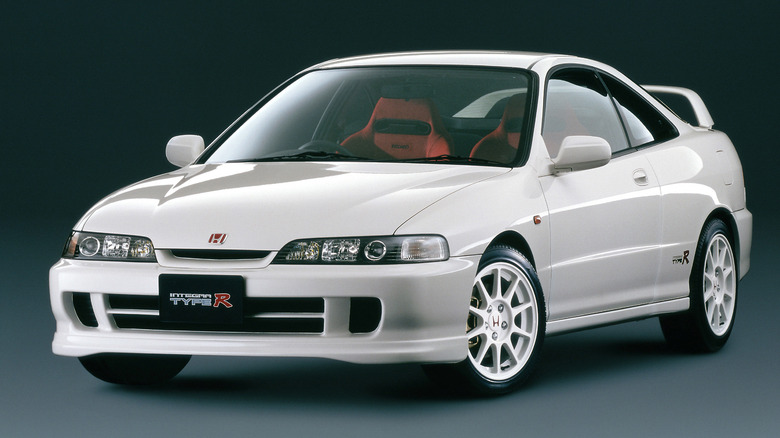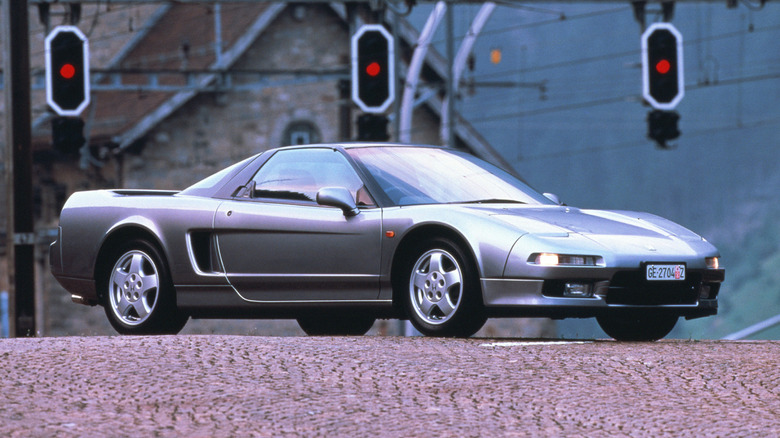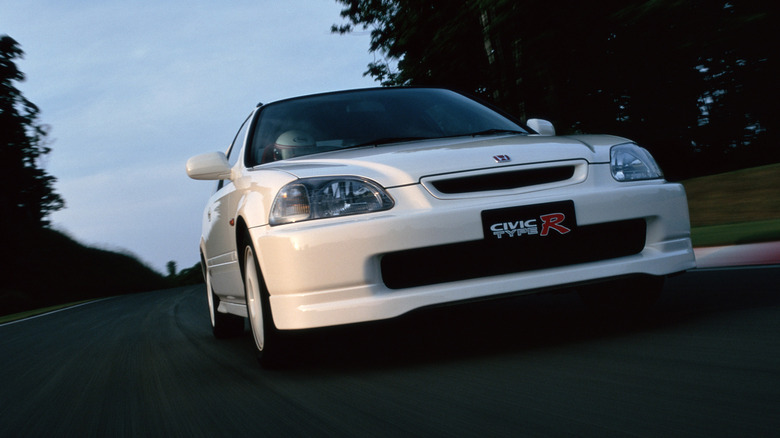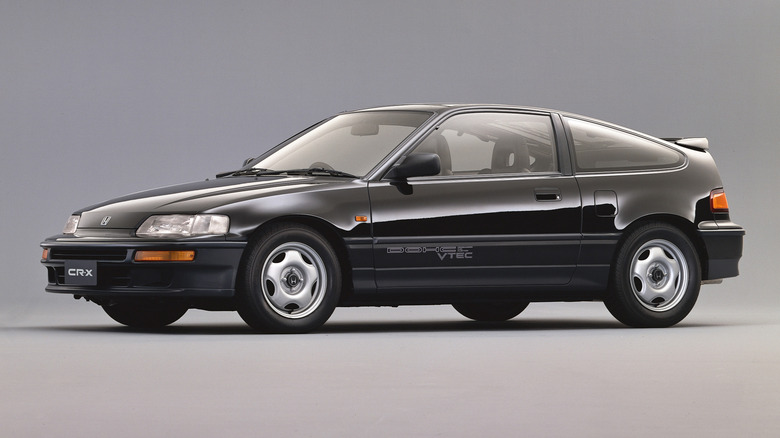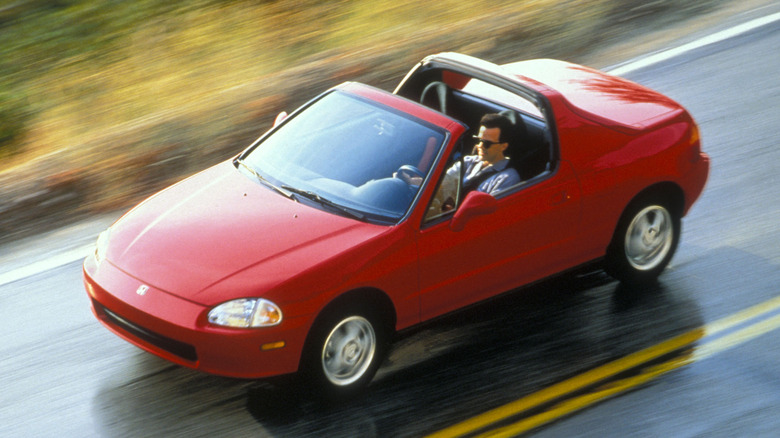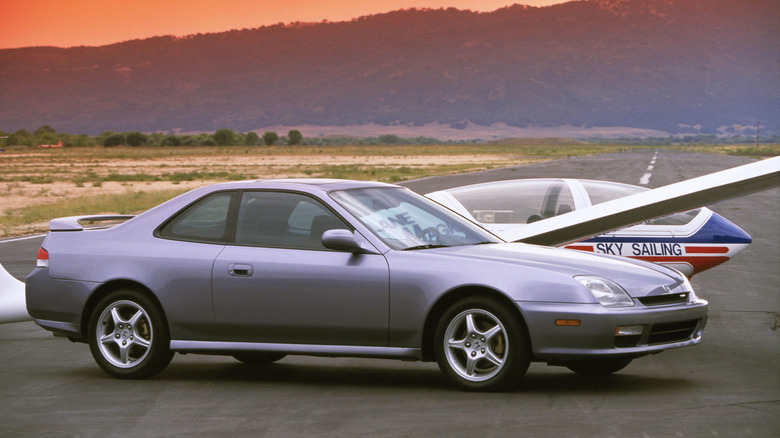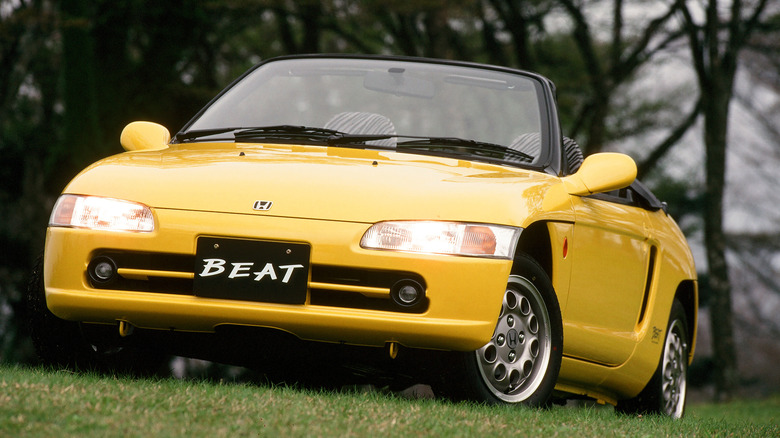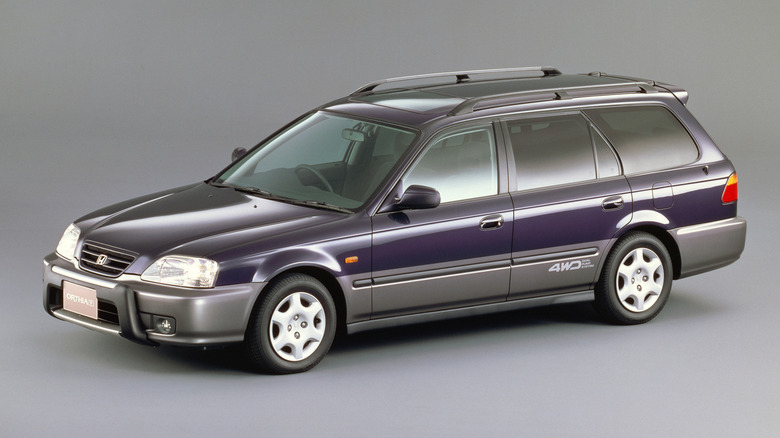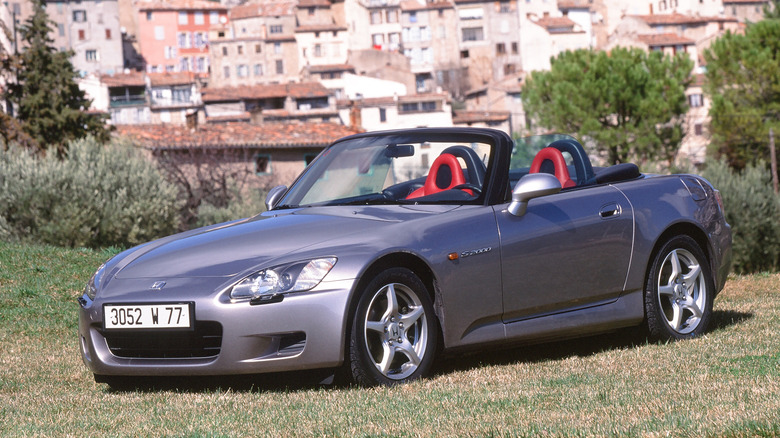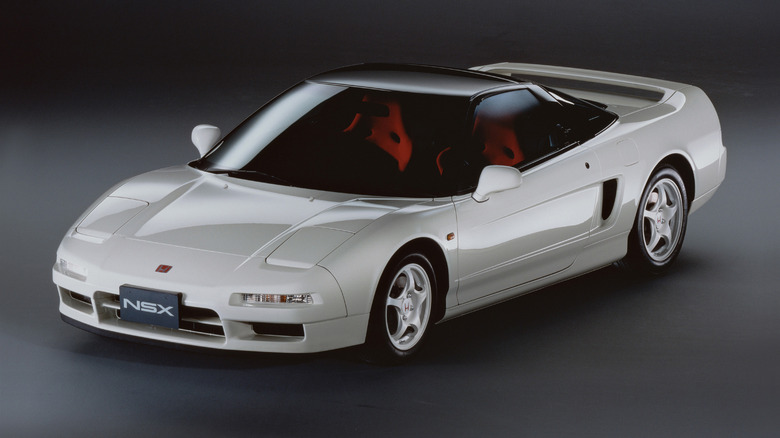10 Of The Coolest Honda Cars From The '90s
The 1990s was not a kind decade for Japanese manufacturers, or for the Japanese economy as a whole. Often referred to as the Lost Decade, the country's economic bubble burst and previously cash-rich manufacturers found themselves having to cut costs to survive. Honda didn't escape the fallout, but it still managed to churn out plenty of cool cars during that period. From supercars to affordable performance hatchbacks, Honda offered cars for a wide variety of enthusiasts.
Some of those models command high prices among collectors today, but plenty of others remain affordable. A few can even be had for relatively bargain prices considering the thrills that they offer. Some of the company's coolest '90s cars have gained enough recognition to be widely considered among Honda's best of all time, while others have remained mostly overlooked. In fact, there's a chance that some enthusiasts might not even know a few of its coolest models even existed.
Whether they're expensive or cheap, well-known or overlooked, these 10 Hondas from the 1990s are our favorites from the decade.
Honda Integra Type R DC2
It wasn't the fastest in a straight line, it wasn't the most tech-forward car of its era, and it wasn't particularly showy compared to later Type R-badged Honda models. Yet, the Integra Type R DC2 is regarded as one of the brand's most impressive cars, primarily thanks to its excellent handling.
The Type R was designed with racing in mind, and so was significantly stiffer than a standard Integra, as well as being lighter. Under the hood sat a 1.8L four-cylinder engine with a split personality — at everyday speeds, it was docile, but at higher revs, it became an entirely different beast. For that, you can thank VTEC, a feature that's become a Honda signature in the years since.
Despite its front-wheel drive layout, the car managed to be both grippy where needed and easily controllable during slides, leaving drivers confident to wring out all of its 190 odd horsepower through the backroads. Its popularity with modders at launch means that relatively few clean examples are available for buyers today, but those that are available are still reasonably priced. According to Classic.com, the current average price for a DC2-generation Integra Type R hovers around $23,000.
Honda/Acura NSX
Another of Honda/Acura's most famous '90s models is the NSX. Honda launched it in 1990 and discontinued it in the mid-'00s due to low sales. The nameplate was revived for 2016, but once again the NSX's brilliance didn't translate to satisfactory sales figures, and it was discontinued once more.
Either way, both generations of the car are arguably unique in the sports car market, since they're designed to be easy and deliver impressive performance. The original NSX was fast, but it wasn't the fastest car of its era. However, it looked more futuristic than anything else on the market, and unlike its European competition, it was reliable enough to be driven every day.
While resale prices for the NSX aren't exactly in bargain territory, the car remains relatively attainable compared to other exotics from its era. Average resale figures sit around the $95,000 mark, although modified or higher mileage examples can be found for significantly less. As well as being attainable to buy, the NSX is more affordable to run than other supercars, and Honda's impeccable quality control means that it should remain a reliable classic even though the oldest examples have been around for 35 years now.
Honda Civic Type R EK9
The first Civic to wear the revered Type R badge appeared in 1997, and it was only available in Japan. Under its hood sat a 1.6L four-cylinder engine that, like the Integra Type R before it, required the driver to head into the highest reaches of its rev range to really shine. Its 185 horsepower output is a modest figure by today's standards, but it was impressive for the era and reportedly enough for a zero to 60 mph time of around six seconds. Equipped to each car was a five-speed manual transmission that, like all Type R Civics after it, sent power to the front wheels only.
Even during its production run, it was a rare car, with around 16,000 reportedly built in total. Today, only a fraction of that original run survives, and even fewer survive in stock condition. Those that do survive have mostly been used and abused by now, and so the few that remain in good condition command a significant premium. Prices for the average example sit at roughly $26,000, but the cleanest examples can cost almost double that figure.
Honda CR-X Si
The original CR-X launched for the 1984 model year, but the Si variant didn't arrive until the following year. It added fuel injection to boost the car's power output to 91 horsepower, as well as several other engine tweaks and a revised cabin. These relatively small changes added up to make a big difference, putting the Si in a class of its own in the market. The second generation CR-X, which arrived in 1988 and remained in production until 1991 — hence its inclusion here — followed the same formula.
The Si was still the top trim, and now churned out 105 horsepower from its 1.6L engine. For 1990, the model was given an interior makeover, but most of its oily bits remained unchanged. The exterior was also tweaked, with new wheels and disc brakes. After its suite of changes for the new decade, the 1991 model year saw no major changes, and it would turn out to be the CR-X Si's last before being discontinued. Its successor, the Del Sol, aimed to deliver the same affordable, fun-to-drive thrills, but for many enthusiasts, it didn't live up to the standard set by the original.
Honda Del Sol
While it's not held in as high regard as the CR-X, the Del Sol has some cool features that make it worthy of this list in its own right. It still featured a VTEC engine, and thanks to its Civic underpinnings, it was still affordable to buy and maintain.
In some markets, a unique TransTop roof was also offered, although Americans had to make do with the notoriously leaky targa top. The problem was that, in redesigning the car to be an open-topped roadster, Honda had pitched the Del Sol as a direct competitor to the Mazda Miata – one of the best Mazdas ever made – and that was a brief it couldn't match.
It didn't sell well enough for Honda to justify continued investment in the car, and as a result, it was discontinued in the U.S. after the 1997 model year without a replacement. Since then, no true replacement has ever arrived, although the hybrid CR-Z is sometimes considered a half-successor.
Honda Prelude Type SH
The revived Prelude has been recently unveiled to considerable fanfare, but one of the best variants of the previous generation remains underrated among enthusiasts. The Prelude Type SH didn't offer the performance upgrades of the Japan-only Prelude Type S, but it did boast unique suspension and an Active Torque Transfer System that could automatically send power to one side of the car when it was cornering at speed. In other aspects, the Type SH was a typical top-spec Honda, with high levels of build quality and a durable if uninspiring interior.
Under its hood sat a 2.2L four-cylinder engine mated to a five-speed manual transmission. That engine churned out 200 horsepower, but like many of the brand's cars from the same era, squeezing out all of those horses required the driver to keep the throttle pinned until the needle pushed past 5,000 rpm. That might sound like an exciting novelty to enthusiasts today, but at the time, it wasn't enough to keep buyers interested in the model. Honda would discontinue the Prelude in 2001.
Honda Beat
With its unusual 660cc engine and tiny size, the Honda Beat is often considered an oddball that is far from an average sports car. It was unveiled as one of a trio of kei sports cars from Japanese automakers in the early '90s alongside the Suzuki Cappuccino and Autozam AZ-1. Its small size and 63 horsepower engine are the result of Honda needing to keep the car within Japanese kei regulations, which made buyers eligible for favorable tax rates and lower insurance premiums.
The Beat was therefore an unusually affordable sports car, and could be bought by younger buyers or those on tighter budgets. That helped make it a popular model in Japan, which was its only market, with over 33,000 examples built before the car was discontinued in 1996.
The Beat's unique looks have helped make it a sought after model with JDM enthusiasts around the world, and plenty of examples have been imported to America. However, its size and power makes it extremely impractical for American roads, and as a result, imported examples don't sell for much. Average prices remain under $10,000, with some examples available for significantly less. It might not be as fast as other '90s Hondas, but for turning heads, few other models provide as much bang for your buck.
Honda Orthia
Even in Japan, the Honda Orthia remains a rare sight. It was a short-lived model that took the platform of the Civic but stretched it into wagon form, then added a four-wheel drive system. In the U.S., Subaru is best known for its off-road ready wagons, but in Japan, the Orthia's domestic competition also included similar models from Toyota and Nissan. The Honda debuted in Japan in 1994, two years after the popular Toyota Caldina and a year after the second-generation Subaru Legacy wagon.
Unfortunately, with so much competition, the Orthia struggled to stand out among buyers. A revised model was launched in 1999 but that didn't do much to boost the model's popularity, and it was discontinued in 2002. Whether it would have been more popular if it had been released overseas is a tricky question — Subaru's wagon was a key part of its international expansion, but without any rallying heritage to draw from, Honda might have had a hard time convincing American buyers that the Orthia was the superior choice for all-terrain use.
Honda S2000
While the Honda S2000 only just qualifies as a '90s car — it entered production in 1999 — it's one of the company's biggest icons, so we couldn't not include it here. It was first unveiled in concept form a few years prior to the start of production, with Pininfarina playing a part in its early styling. Like most other Hondas of its era, the S2000's high rev limit was there for a reason, and drivers needed to reach the top end of its range to coax out its full power.
Despite being initially met with mixed reviews from critics, the S2000 proved a commercial success, with over 110,000 examples produced over a decade-long production run. That was close to Honda's self-enforced limit of 12,000 cars per year, set because of production constraints at the brand's Takanezawa plant.
As well as being great to drive, the S2000 was also surprisingly efficient, and conformed to all global emissions regulations including California's demanding LEV rules. Its horsepower-per-liter ratio was also the highest of any naturally aspirated engine ever produced at the time of its unveiling.
Honda NSX Type R
Before the Civic or Integra took the badge to global fame, the first Honda to wear a Type R badge was the NSX. The NSX Type R was a very special Honda launched in 1992 and featured retuned suspension and a lightweight package that involved stripping virtually every non-essential component out of the car. Only 500 were built before the model was discontinued in 1995, with every example sold to the Japanese market.
Honda would resurrect the Type R designation twice more during the NSX's original production run, although neither would be in the '90s. The second NSX Type R, referred to as the NSX-R, put the car through an even more thorough weight reduction program and boosted its power output. A total of 140 examples of the second generation were built, all in 2002. An ultra-limited third generation NSX Type R appeared in 2005 to homologate the car for racing. Called the NSX R GT, it's by far the rarest NSX ever built, with only five leaving the factory.
On the rare occasion that an NSX Type R appears for sale, it commands significantly higher prices than the standard NSX. At auction, one '90s NSX Type R has reached a record price of $632,000, and two further examples have sold for over $300,000 in recent years.
